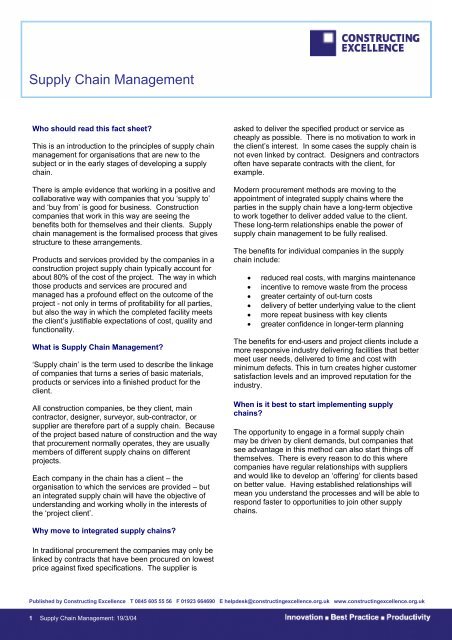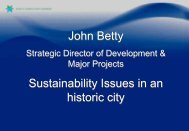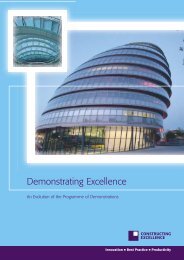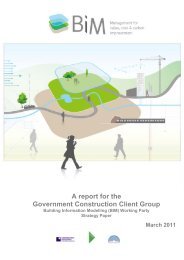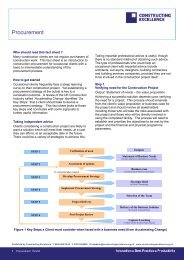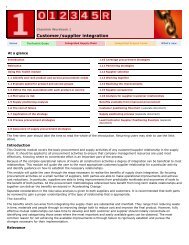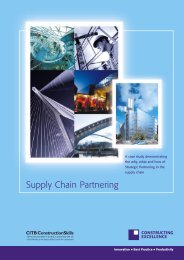Supply Chain Management Factsheet - Constructing Excellence
Supply Chain Management Factsheet - Constructing Excellence
Supply Chain Management Factsheet - Constructing Excellence
Create successful ePaper yourself
Turn your PDF publications into a flip-book with our unique Google optimized e-Paper software.
<strong>Supply</strong> <strong>Chain</strong> <strong>Management</strong>Who should read this fact sheet?This is an introduction to the principles of supply chainmanagement for organisations that are new to thesubject or in the early stages of developing a supplychain.There is ample evidence that working in a positive andcollaborative way with companies that you ‘supply to’and ‘buy from’ is good for business. Constructioncompanies that work in this way are seeing thebenefits both for themselves and their clients. <strong>Supply</strong>chain management is the formalised process that givesstructure to these arrangements.Products and services provided by the companies in aconstruction project supply chain typically account forabout 80% of the cost of the project. The way in whichthose products and services are procured andmanaged has a profound effect on the outcome of theproject - not only in terms of profitability for all parties,but also the way in which the completed facility meetsthe client’s justifiable expectations of cost, quality andfunctionality.What is <strong>Supply</strong> <strong>Chain</strong> <strong>Management</strong>?‘<strong>Supply</strong> chain’ is the term used to describe the linkageof companies that turns a series of basic materials,products or services into a finished product for theclient.All construction companies, be they client, maincontractor, designer, surveyor, sub-contractor, orsupplier are therefore part of a supply chain. Becauseof the project based nature of construction and the waythat procurement normally operates, they are usuallymembers of different supply chains on differentprojects.Each company in the chain has a client – theorganisation to which the services are provided – butan integrated supply chain will have the objective ofunderstanding and working wholly in the interests ofthe ‘project client’.asked to deliver the specified product or service ascheaply as possible. There is no motivation to work inthe client’s interest. In some cases the supply chain isnot even linked by contract. Designers and contractorsoften have separate contracts with the client, forexample.Modern procurement methods are moving to theappointment of integrated supply chains where theparties in the supply chain have a long-term objectiveto work together to deliver added value to the client.These long-term relationships enable the power ofsupply chain management to be fully realised.The benefits for individual companies in the supplychain include:• reduced real costs, with margins maintenance• incentive to remove waste from the process• greater certainty of out-turn costs• delivery of better underlying value to the client• more repeat business with key clients• greater confidence in longer-term planningThe benefits for end-users and project clients include amore responsive industry delivering facilities that bettermeet user needs, delivered to time and cost withminimum defects. This in turn creates higher customersatisfaction levels and an improved reputation for theindustry.When is it best to start implementing supplychains?The opportunity to engage in a formal supply chainmay be driven by client demands, but companies thatsee advantage in this method can also start things offthemselves. There is every reason to do this wherecompanies have regular relationships with suppliersand would like to develop an ‘offering’ for clients basedon better value. Having established relationships willmean you understand the processes and will be able torespond faster to opportunities to join other supplychains.Why move to integrated supply chains?In traditional procurement the companies may only belinked by contracts that have been procured on lowestprice against fixed specifications. The supplier isPublished by <strong>Constructing</strong> <strong>Excellence</strong> T 0845 605 55 56 F 01923 664690 E helpdesk@constructingexcellence.org.uk www.constructingexcellence.org.uk1 <strong>Supply</strong> <strong>Chain</strong> <strong>Management</strong>: 19/3/04
<strong>Supply</strong> <strong>Chain</strong> <strong>Management</strong>How do we get started?Whether the supply chain is being established for awhole project or by a group of companies wishing tomarket their specialisms, the following principles apply:It is likely to be impractical to establish long-termrelationships with all members of the supply chain.So you should start by establishing relationships withthose suppliers and sub-contractors who are critical toyour delivery to the market of better products at lowercost and higher quality. These are your strategicsupply chain partners or ‘first tier suppliers’. It is vitalthat you take time and care to establish whichcompanies fulfil the criteria that you set (or have thepotential to do so) and that they have similar intereststo you in developing long term relations. A successfulsupply chain of first tier suppliers is a manageableobjective. In time you may plan for each of yoursuppliers to have similar chains, but don’t try toconquer the world in one go.Evaluate and compare potential first tier suppliers’strengths and capabilities in the following areas:- the strength of the existing relationship- technical capability and reputation- design capability and innovation record- size and market position- management styleconstruction professionals. Developing successfulsupply chains will therefore be difficult and take timebut the rewards will be worthwhile.Involving the designer in the supply chain isessential to long-term success.For a whole project supply chain, there may be anumber of professional design teams (architect,structural engineer, services engineer) that need to beinvolved. On the other hand, where the supply chain isestablished to deliver a component, the designer maybe embedded within one of the supply chain partners.Either way, the designer’s role is central to delivering:• Optional functionality• Lowest cost of ownership through a value formoney focus on lowest through-life cost• Safe construction using least amount labourand minimum waste.Managing CostCentral to successful collaborative relationships is theapproach to cost management. The most enlightenedclients accept they will obtain best value if the supplychain’s margins are offered some protection. That willallow the supply chain to focus on delivering value tothe client rather than using its efforts to protectmargins.Remember you are seeking partners capable ofreliably supplying you with products and services atcompetitive prices. Success will deliver mutualcommercial benefit through greater success in themarket, based on increasingly satisfied clients. Allparties in the supply chain must be committed toworking for the long term on the basis of continuousimprovement and innovation. If anyone is inclined toquit when the going gets tough, the supply chain willfail.Ring-fenceManage out(risk management)Optimise –target costingsupported byVM/VEMarginsRisk allowancesComponent andprocess costs}PRICEMuch of the success of supply chains rests onpersonal relations so look at the guidance that isavailable on Partnering (see fact sheet).Key personal actions are to be proactive, lessadversarial, and to learn from others. Neitherpartnering nor supply chain management are easy.The parties do not need to be good friends, however.Relationships need to be fair but firm, based on a teamapproach which involves regular contact and mutualrespect. Learning to work in this way is new for mostEven where the supply chain cannot get suchagreements from a client, it is still essential that costsare understood and managed. The principle of sharingrisk and reward underpins the whole process ofcollaborating for mutual benefit. Passing all risk downthe supply chain does not lead to the lowest cost andcertainly does not lead to best value for the client.Gain/pain sharing incentive schemes will often ensurethe continuing delivery of optimum value to the client.Published by <strong>Constructing</strong> <strong>Excellence</strong> T 0845 605 55 56 F 01923 664690 E helpdesk@constructingexcellence.org.uk www.constructingexcellence.org.uk2 <strong>Supply</strong> <strong>Chain</strong> <strong>Management</strong>: 19/3/04
<strong>Supply</strong> <strong>Chain</strong> <strong>Management</strong>The optimisation of component and process costs -which typically amount to 80% of the cost of a project -should be approached from target costing, supportedby value management, to determine the realrequirement. (Value management should engage allthe stakeholders in the project, including the ultimateend-users.) Value engineering should then be used asthe design progresses to optimise the engineering ofthe elements.Risk allowances, which are typically made separatelyby all suppliers, should be rigorously identified usingrisk management techniques. Duplication should beeliminated, measures taken to manage out the risk andresidual risks placed with the most appropriate owner.Substantial savings should be achievable over targetcosts using these techniques. In repeat applications,the component and process costs can be furtherimproved by the application of continuous improvementtechniques. Manufacturing experience is that there willalways be room for continuing cost reductions.SummaryThe key objective of supply chain management is tooffer better underlying value to a client than thecompetition. This is done through a combination of• defining client value• establishing supplier relationships• Integrating activities• Managing costs collaboratively• Developing continuous improvement• Mobilising and developing peopleFor more detailed guidance:The Strategic Forum Toolkit - web only -www.strategicforum.org.ukSponsored by the pan-industry Strategic Forum forConstruction, the purpose of this web toolkit is todeliver the integration described in AcceleratingChange. It enables clients and the industry to lead bydeveloping continuously improving supply chains,collaboratively working in world class project teamsdelivering superior products and services. The toolkitprovides the framework for focused and empoweredpeople to perform and for respecting their diversity,health, safety and welfare.Modernising construction, National Audit Office,2001 – available from www.tso.co.ukReviews historic and structural problems of theconstruction industry. Examines progress made by theGovernment in promoting innovation and goodpractice. Concludes that there is no excuse forgovernment clients and the industry to fail to takeadvantage of readily available solutions. Recommendsthat industry and clients should implement goodpractice in the areas of selecting contractors by value;better relationships between clients and the supplychain; integration of the supply chain.Achieving <strong>Excellence</strong> Guidance, Office ofGovernment Commerce, 2003 – available on-line atwww.ogc.gov.uk/sdtoolkit/reference/achievingThe Achieving <strong>Excellence</strong> suite of procurementguidance replaces the Treasury ConstructionProcurement Guidance Notes. This new series reflectsdevelopments in construction procurement over recentyears and builds on Government Departments’experience of implementing Achieving <strong>Excellence</strong>. Thenew guidance aligns with the OGC Gateway process,the emerging lessons learned from Gateway reviewsand the Successful Delivery Toolkit, of which it forms akey component.The suite consists of three core and eight supportingdocuments together with two high level documents.Electronic versions have hyperlinks across the set andto related products.The handbook of supply chain management, CIRIAC546, 2000 - available fromhttp://www.ciria.org/acatalogSets out the principles of supply chain management forconstruction based on the findings of the full scalepilots by Defence Estates known as Building DownBarriers. These two projects showed that projectsdelighting the end-user can be delivered ahead of time,with few defects and at 14% below benchmark wholelife costs.Rethinking construction training pack, CIRIA C576,2003 – available from http://www.ciria.org/acatalogPublished by <strong>Constructing</strong> <strong>Excellence</strong> T 0845 605 55 56 F 01923 664690 E helpdesk@constructingexcellence.org.uk www.constructingexcellence.org.uk3 <strong>Supply</strong> <strong>Chain</strong> <strong>Management</strong>: 19/3/04
<strong>Supply</strong> <strong>Chain</strong> <strong>Management</strong>Takes the principles set out in the Handbook of SCMand develops them into detailed techniques in the formof a training pack which can be used in-house oracross supply chains. The techniques wereestablished and tested collaboratively with a number ofleading industry companies.The seven pillars of partnering, Bennett & Jayes,Thomas Telford, 1998 - available fromhttp://www.thomastelford.com/books andwww.amazon.co.ukDescribes best practice in partnering in theconstruction industry, and identifies what needs to bedone to meet the new demands arising from a rapidlychanging market and from new technologiesStrategic Procurement in construction, Cox &Townsend, Thomas Telford, 1998 – available fromhttp://www.thomastelford.com/books andwww.amazon.co.ukConsiders the nature of the UK construction industryand looks at the limitations of conventionalprocurement systems and the need for newapproaches to procurement. Analyses the use ofsupply chain management and other strategicprocurement techniques and outlines genericapproaches to better practice. Uses a number of casestudies to demonstrate the process and practicesdescribed.Value management in construction, CIRIA SP129,1996 – available from http://www.ciria.org/acatalogPublished by <strong>Constructing</strong> <strong>Excellence</strong> T 0845 605 55 56 F 01923 664690 E helpdesk@constructingexcellence.org.uk www.constructingexcellence.org.uk4 <strong>Supply</strong> <strong>Chain</strong> <strong>Management</strong>: 19/3/04


